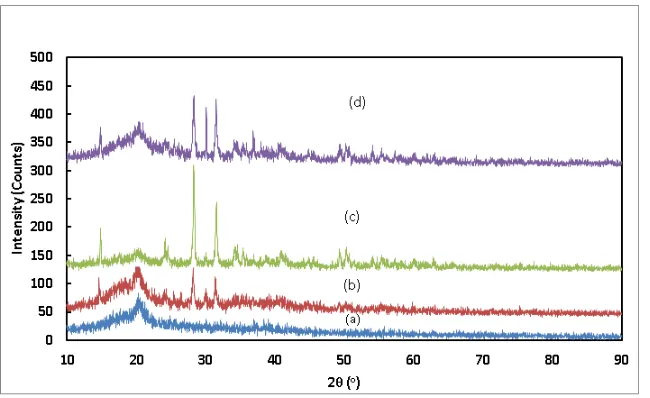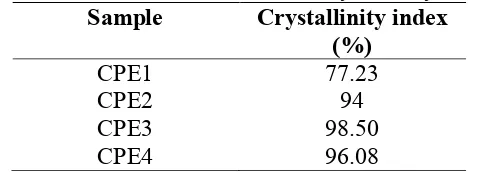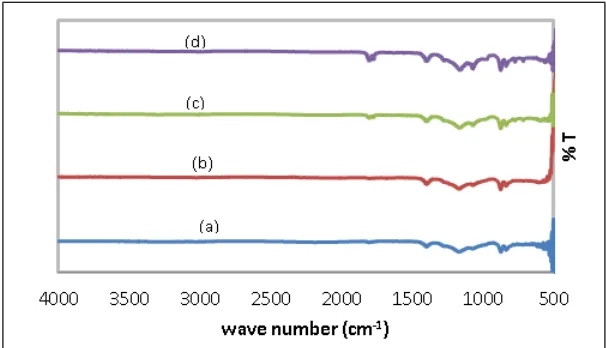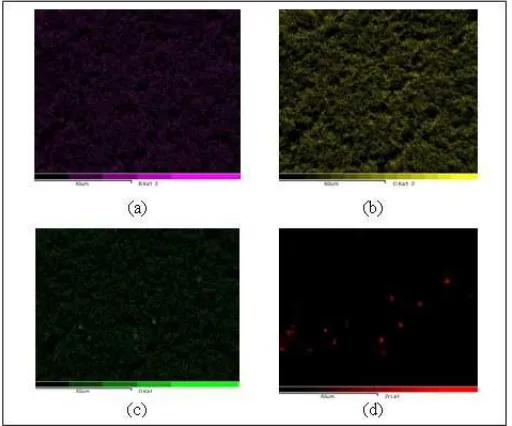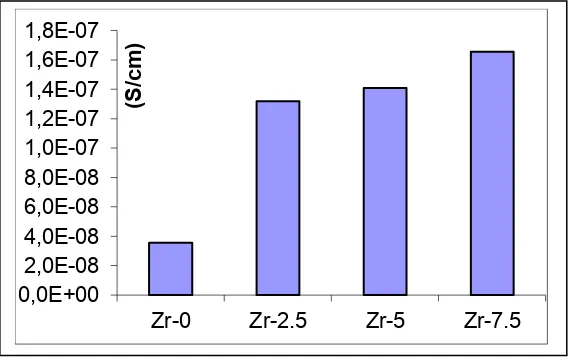The journal homepage www.jpacr.ub.ac.id p-ISSN : 2302 – 4690 | e-ISSN : 2541 – 0733
Synthesis and Characterization of PVDF-LiBOB Electrolyte
Membrane with ZrO
2as Additives
Etty Marti Wigayati1, Moh Rosyid Ridho1, Achmad Subhan1, Ibrahim Purawiardi1
1
Research Center for Physics, Indonesian Institute of Sciences Kawasan Puspiptek Serpong Gd. 442, Tangerang Selatan – Banten
*
Corresponding Author. E-mail:[email protected]
Received 6 July 2017; Accepted 25 August 2017
ABSTRACT
The electrolyte membrane serves as ions medium transport and as a separator between the anode and cathode in lithium ion battery. The polymer used for the electrolyte membrane must have sufficiently high mechanical strength to endure the pressure between the anode and cathode, a thin size and has a chemical and thermal stability.
Polymer electrolyte membrane of lithium bisoxalate Borate (LiBOB) salt with PVdF as matrix polymer and the additive namely ZrO2 has been fabricated. The method used was
a doctor blade. The concentration of the additive was varied. The membranes were characterized using FT-IR, XRD, SEM and EIS. XRD analysis showed that the crystallinity index increased by the addition of ZrO2. The presence of functional groups in between
lithium salts and polymer interaction investigated by FTIR analysis.The morphology of the membrane surface was identified by SEM analysis. SEM image and mapping showed the morphology of the membrane have typical porous layer. The electrical conductivity increased by the additions of ZrO2.
Key word: additive, cristalinity index, electrical conductivity, morphology
INTRODUCTION
Electrolytes play an important role in the lithium-ion battery system for the transfer of ions. Lithium-ion batteries typically use a liquid electrolyte consisting of a lithium hexafluorophosphate (LiPF6) and carbonate solvents such as ethylene carbonate (EC),
propylene carbonate (PC), dimethyl carbonate (DMC), ethyl methyl carbonate (EMC) or diethyl carbonate (DEC). LiPF6 has conductivity higher than 10-2 Scm-1 at room temperature,
but low thermal stability at high temperatures [1-2]. LiPF6 even decomposed into LiF and PF5
then react with H2O to form HF, which is destructive to the battery cathode cells [1,3].
The polymer electrolyte is more developed to obtain lithium-ion batteries that are thinner, lighter, but it has to meet safety qualities [5]. Several studies like PEO addition have investigated a wide range of polymers to be used as the host polymer in polymer electrolyte systems such as polymethyl methacrylate (PMMA), polyvinyl alcohol (PVA), polyacrylonitrile (PAN), and polyvinylidene fluoride (PVdF). PVdF has advantages over other polymers such as dipole moments and high dielectric constant, which is important for the ionization of lithium salt [6]. In addition, the PVdF is also superior in terms of mechanical strength, the interaction of electrode-electrolyte, good control for porosity in the doubles system solvent/polymer, also the high stability of the anodic due to the presence of functional groups C-F which has the property of attracting strong electron [7]. Safety and durability makes the solid polymer electrolyte started more developed to replace conventional electrolyte in liquid form.
There are three types of polymer electrolyte: solid polymer electrolyte, gel polymer electrolyte, and porous solid polymer electrolyte [8-9]. Solid polymer electrolyte has a higher mechanical strength than gel polymer electrolyte.
Electrolyte membrane is a matrical solid electrolyte which is a solid solution of alkali metals in the polymer [10]. Electrolyte membrane has the advantages such as the ion conductivity and the energy density is high enough, leak-proof, solvent-free, have electrochemical stability, easily manufactured, and light. Membrane electrolyte in lithium ion battery has a dual function as a medium transport of ions (replacement electrolyte solution) and as a separator between the cathode and the anode. In the later development the required electrolyte membrane has the characteristics: high conductivity, mechanically strong, thermal stability and can be produced inexpensively. Various polymers have been used for the electrolyte membrane, for example PVdF, PVA, cellulose acetate, polyacrylonitrile-methyl methacrylate P (AN-MMA).
Figure 1. Schematic of “Ceramic/polimer composite concept [13]
ZrO2 has excellent thermodynamic properties of ZrO2, high ionic conductivity, strong
and stable [11-12]. Schematically, lithium ion polymer was depicted in Figure 1.
In this research, the solid polymer electrolyte (SPE) membrane has been prepared. Composites made from LiBOB as active material and PVdF polymer as a matrix. ZrO2 was
EXPERIMENT
Chemicals and instrumentation
PVdF was purchased from Sigma Aldrich with purity> 98% and a molecular weight> 180,000 (GPC). Solvent N,N-dimethylacetamide (DMAC) were purchased from Merck with purity > 99%. ZrO2 was obtained from Kanto Chemical Co. EC / DEC were obtained from
Merck with purity> 98%, and LiBOB salt was synthesized using solid state reaction according to Wigayati, et.al.[19,20].
The process was conducted by mixing for membrane preparation was used a magnetic stirrer on hotplate IKA C- MAG HS-7. The analysisthe crystalline structures and crystallinity were analyzed using XRD Rigaku SmartLab type with Cu Kα radiation in the range of 2θ = 0-80o then the results are analyzed using the software PDXL. The functional groups were analyzed using FT-IR Thermoscientific type Nicolet iS-10 machine by attenuated total reflectance (ATR) method in the range of wave number 4000-600 cm-1. The surface morphology of membrane characterization using Scanning Electron Microscope (SEM) Hitachi SU-350 types operated at 10-20 kV acceleration voltage. The electrical conductivity was analyzed using Hioki 3522-50 LCR HiTESTER type.
Procedure reaction
PVdF dissolved in DMAC and stirred using a magnetic stirrer with a speed of 250 rpm was put on a hot plate at a temperature of 50°C. LiBOB salt mixed in EC and DEC until dissolved. Then two solutions were mixed together and added by ZrO2. Obtained solution was
stirred continuously until the mixture becomes homogeneous viscous liquid appearance. The solutions were cast on to a glass substrate plates using doctor blade methods with films thickness of 100 μm, and allowed to evaporate slowly at room temperature. The polymer electrolyte membrane composition showed in Table 1.
Table 1. Composition of the polymer electrolyte membrane (in percent by weight)
Sample PVDF EC DEC LiBOB ZrO2
Characterization of PVdF-LiBOB-ZrO2 polymer electrolyte membrane
Characterization of surface morphology of the PVdF-LiBOB-ZrO2 polymer electrolyte
membrane was performed by a scanning electron microscope (SEM). Phase and the crystal structure of the polymer electrolyte membrane were observed by X-ray diffraction analysis (XRD). Samples were scanned using XRD. Analysis of the functional groups and the bond between molecules was done using Fourier Transform Infra-Red spectroscopy (FT-IR).
Test impedance the polymer electrolyte membrane sheet made by electrochemical impedance spectroscopy (EIS). The samples were placed between stainless steel plates in an area of 9.64 mm2 and AC current is applied in the frequency range of 0.5 Hz to 100,000 Hz. Conductivity (σ) can be calculated using the formula :
R A L
b
where L and A are each the polymer electrolyte membrane thickness and sample size respectively, while the bulk resistance Rb is obtained from Cole-Cole plot impedance test
results.
RESULT AND DISCUSSION XRD analysis
The resulted crystal structure and composition of the PVdF-LiBOB-ZrO2 polymer
electrolyte membrane shown in Figure 2 XRD analysis.
Figure 2. The diffraction pattern the PVdF-LiBOB-ZrO2 polymer electrolyte
membrane with ZrO2 (a) 0%, (b) 2,5%, (c) 5% and (d) 7,5%.
The formed phase is shown in Figure 2(a). The results of the analysis of diffraction
peaks indicating the presence of β-PVdF (CF2CH2)n phase of ICDD (PDF-4+2015 RDB) DB
card number 00-061-1404, at the height of the 2θ= 20.85, 36.72 and 41.45, as well as on the hkl plane each peaks (2,0,0), (0,0,1) and (2,0,1). LiBOB phase does not appear because in the sample PEM 1 the PVdF is more dominant than LiBOB particles, so the detected phase is PVdF.
The sample PEM 2 results phases Baddeleyite syn (ZrO2), ICDD (PDF-4 + 2015 RDB)
DB card number 01-083-0940 and LiBOB hydrate (LiB(C2O4)2(H2O) by ICDD (PDF-4+2015
RDB) DB card number 01-073-9447, the diffraction peaks at 2θ = 20.22, 28.20 and 31.48 and the hkl plane at each peaks (0,2,1), (4.1, 1) and (1,1,1).
The sample PEM 3 provides phases syn baddeleyite syn (ZrO2) with a percentage of
84% ICDD (PDF-4+2015 RDB) DB card number 01-083-0944; Tazheranite, syn (ZrO2) by
ICDD (PDF-4+2015 RDB) DB card number 00-049-1642 and LiBOB hydrate (LiB(C2O4)2(H2O) by ICDD (PDF-4+2015 RDB) DB card number 01-073-9447 the height of
the diffraction peaks at 2θ= 20:53; 28.31 and 31.49, as well as the hkl plane at each peaks (0,2,1), (1,1, -1) and ( 1,1,1).
The sample PEM 4, the phases formed is Zirconium Oxide (ZrO2) by ICDD
(PDF-4+2015 RDB) DB card number 04-005-4478; Baddeleyite, syn (ZrO2) by ICDD
(PDF-4+2015 RDB) DB card number 00-036-0420 and LiBOB hydrate (LiB(C2O4)2(H2O) by
at 2θ= 20.34, 28.29 and 31.54, as well as the hkl plane at each peaks (4,0,0), (4,3,1) and (1, 1.1). At 2θ = 36.93 a new peak represents the LiBOB hydrate (LiB (C2O4)2(H2O) phase.
From this analysis ZrO2 is metal therefore it appears as dominant phase in the diffraction
pattern, while the LiBOB phase appears in the form LiBOB hydrate because the hygroscopic properties of LiBOB was binding with the water vapor in the air.
Crystallinity index of the polymer electrolyte membrane do by peak height method [14]. Crystallinity indexs (CI) were calculated using the formula:
max
where Imax = highest intensity on the crystal diffraction peak and Imin = lowest intensity in the
valley crystal diffraction.
Calculation results are displayed in Table 2. From the analysis it appears that the crystallinity index of the polymer electrolyte membrane increases with the addition of ZrO2, due to the
ZrO2 is metal.
Table 2. The calculation results of crystallinity index
Sample Crystallinity index
Figure 3 is an FT-IR spectrum, which showed the presence of functional groups PVdF and LiBOB appearing on the polymer electrolyte membrane sheet. The peaks of the wave number 1807 cm-1, 1777 cm-1, 1071 cm-1 and 876 cm-1, is a fingerprint typical compound LiBOB, each of which showed the vibration of the oscillation C=O, C-O-O strain asymmetric O-B-O asymmetrical strain, and C-O-O buckling vibration.
The PVdF polymer fingerprint peak also appears at wave number 1403 cm-1, which CH2 cut out and C-F strain at wave number 1074 cm-1. Also visible fingerprint peaks typical
β-PVdF phase at wave number 838 cm-1, the CH2 wobble, strain asymmetric of CF2 [15].
CH2 in-plane bending is the characteristic fingerprints vibration of phase β-PVdF. The wave
Figure 3. FTIR spectra of the sample PVdF-LiBOB-ZrO2 polymer electrolyte membrane
by the addition of ZrO2 (a) 0%, ZrO2 (b) 2.5% ZrO2 (c) 5%, ZrO2 (d) 7.5%
SEM analysis
The polymer electrolyte membrane morphology showed in Figure 4. The Figure 4 is SEM analysis result was taken at 5000x magnification. From these images it appears that LiBOB particles are spread evenly throughout the matrix layer PVdF (Figure 4a). By the addition of ZrO2 particles it grows more dense and homogeneous, ZrO2 particles filling the
space between the PVdF-LiBOB. Figure 5 shows the corresponding Energy Dispersive Spectroscopy (EDS) compositional mapping of the elements B, C, O, Zr in the polymer electrolyte membrane sample by addition of 7.5% ZrO2, indicating that the elements B, C, O,
Zr units uniformly dispersed in the polymer electrolyte membrane.
The addition of ZrO2 nanoparticles are dispersed homogeneously into the polymer
matrix resulting in bonding between particles in the polymer chain bonded strongly with each other to form a membrane. The presence of nanoparticles dispersed between polymer chains inhibits reconstruction of intercellular polymer chains into crystalline form. When the temperature returns to room temperature, the polymer chain remains in the random or amorphous phase. With the survival of the amorphous state at low temperatures, the polymer conductivity will remain high at low temperatures [16]. In the sample by addition of ZrO2
Figure 4. SEM picture of the surface of the PVdF-LiBOB-ZrO2 polymer electrolyte
membrane with variations of ZrO2 (a) 0%; (B) 2.5%; (C) 5% and (d) 7.5%
Figure 5. The results of the EDS analysis of mapping the elements (a) boron, (c) carbon, (o) oxygen and (d) Zr at the PVdF-LiBOB-ZrO2 polymer electrolyte membrane
The electrical conductivity analysis
The conductivity of the PVdF-LiBOB-ZrO2 polymer electrolite membrane sheet tested
by electrochemical impedance spectroscopy (EIS) and the results are shown in the Cole-Cole plot in Figure 6. The resistivity obtained from Cole-Cole plots are used to calculate the conductivity of the polymer electrolyte membrane sheet. Conductivity the PVdF-LiBOB-ZrO2 membrane sheet by the addition of ZrO2 0%, 2.5%, 5% and 7.5% are 3.55 × 10-8 Scm-1;
1.32 × 10-7 Scm-1; 1.41 × 10-7 Scm-1 and 1.65 × 10-7 Scm-1, respectively at room temperature (Figure 7). The impedance test results show that the conductivity increases by the the addition of ZrO2. At a concentration of 0% ZrO2, LiBOB particles which serve as a conductor
Figure 6. Cole-Cole plot impedance test results of the PVdF-LiBOB-ZrO2 polymer
electrolite membrane with a concentration of ZrO2 (a) 0%; (B) 2.5%; (C) 5% and (d)
7.5%
Figure 7. Ionic conductivity of the PVdF-LiBOB-ZrO2 polymer electrolyte membrane
with a concentration of ZrO2 (a) 0%; (B) 2.5%; (C) 5% and (d) 7.5%
The highest conductivity is at a concentration of 7.5% ZrO2. This is because ZrO2 is a
conductive metal. The increase in ionic conductivity are not significant to the increase of the addition of ZrO2, analysts SEM show that with the addition of ZrO2 the pores is reduced, the
particles become denser, so the ion moving space is limited and caused the ion electric conductivity is decreased[17]. The increase in electrical conductivity can be explained from the diffraction pattern (Figure 2). In the field of (1,1,1) at an angle 2θ = 31.480 the phase is ZrO2. In 0% ZrO2 the peak intensity is low. With increasing ZrO2 from 2.5% the peak
intensity increased and further increase in 7.5% of ZrO2.
From the Electrical conductivity test the addition of ZrO2 increasing of the value of
0,0E+00 2,0E-08 4,0E-08 6,0E-08 8,0E-08 1,0E-07 1,2E-07 1,4E-07 1,6E-07 1,8E-07
Zr-0 Zr-2.5 Zr-5 Zr-7.5
(S/
c
m
the cathode so that what is needed is the passage of ions), because the value is only changed no more than rank one[18]. Then it can still be expected the electrical conductivity value will be increased with the addition of ZrO2 which is needed in the next cell test.
CONCLUSIONS
The PVdF-LiBOB-ZrO2 polymer electrolyte membrane has been successfully prepared
by methods doctor blade. The crystallinity index increases by the addition of ZrO2. The
electrical conductivity obtained 1.65 × 10-7 Scm-1 at room temperature on samples with the addition of 7.5% ZrO2. The addition of ZrO2 results in increased ionic conductivity. The
morphology of the sample surface looks flat, with the spread evenly additive and more denses with increasing ZrO2 additives.
The addition of ZrO2 to the PVdF-LiBOB polymer composite produces a better membrane,
but does not provide a significant increase in electrical conductivity.
ACKNOWLEDGMENTS
This work was supported by Research Center for Physics Department, Indonesian Institute of Sciences through Sinas program budget year of 2016, No: 292SP2H/LT/DRPM/III/2016,10 Mach 2016.
REFERENCES
[1] Larush-Asraf, L., Biton, M., Teller, H., Zinigrad, E. and Aurbach, D., J. Power Sources, 2007, 174, 400–407.
[2] J. Zhang, B. Sun, X. Huang, G. Wang, Conference Proceedings APEnergy, 2014. [3] Wu, X.-L. Xin, S. Seo, H., Kim. J., Guo, G., and Lee, J., Solid State Ion., 2011,186,
[12] M.M. Navarra, C.Abbati, B.Scrosati, J. Power Sources, 2008, 183(1), 109–113. [13] Kobayasyi, Y., S. Seki, A. Yamanaka, H. Miyashiro, Y. Mita, T. Iwahori, J. Power
Souces, 2005, 146, 719–722.
527.
[16] Abdullah, M., Lenggono, W., dan Okuyama, K. Encyc. Nanosci. And Nanotechnol., 2004, 8, 731–762
[17] Aravindan V, Vickraman P, J. Phys D: Apply. Phys, 2007, 40, 6754–6759. [18] J. Y. Kim, D. Y. Lim, Energies, 2010, 3, 866–885.
[19] Wigayati, E.M., T. Lestariningsih, A. Subhan, C. R. Ratri, I. Purawiardi, Ionics, 2015, 22(1), 43–50.
[20] E. M. Wigayati, C. R. Ratri, I. Purawiardi, F.Rohman, T. Lestariningsih, Indones. J.
![Figure 1. Schematic of “Ceramic/polimer composite concept [13]](https://thumb-ap.123doks.com/thumbv2/123dok/3173538.1388204/2.595.202.440.459.620/figure-schematic-of-ceramic-polimer-composite-concept.webp)
